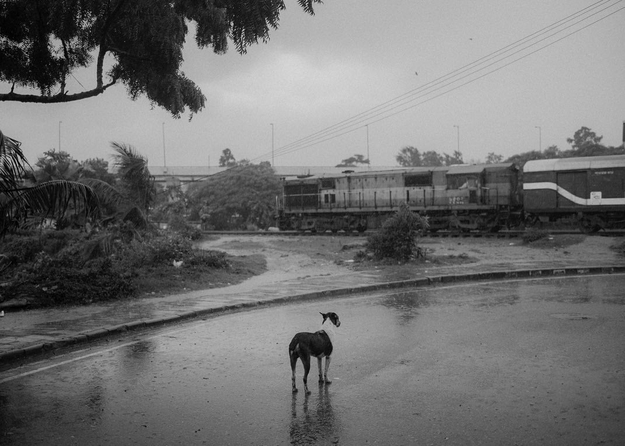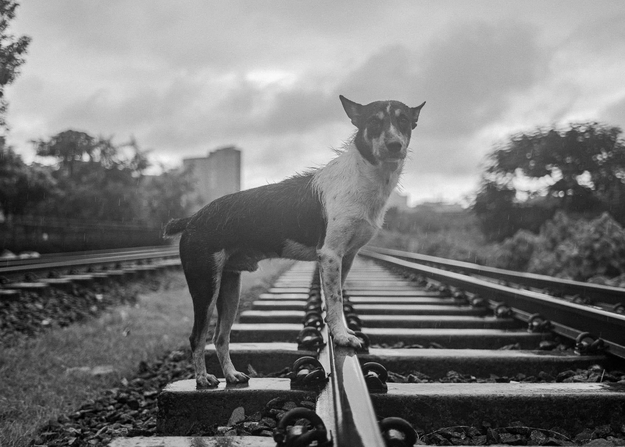This particular photo (above) of a Dhaka dog taken by Sarker Protik reminds me of my own childhood. Protik is a Bangladeshi photographer whose photography often reveals a mysterious, unfamiliar and deterritorialized world within our ordinary world, and this photo is one such example. It pulls me out of my current familiarity and throws me into a different space-time, where I belonged as a child. It reminds me of my first dog companion, and it makes me identify my own child-self with the dog itself. Growing up in a village turned suburb of southern Dhaka, a rail line similar to this photo was a horizon that marked the limit of my childhood world and held a mysterious unknown beyond it. I have lost that horizon and that mystery long ago, by growing up, and by seeing my village turning into one of the biggest slums of the late capitalist world. Now, like many of the world's population, I find myself in a dystopian temporality which has been given the name of Anthropocene by climate scientists. It’s a period in which human beings (Anthropos) have become the central character responsible for geological changes as they have created a civilization powered by fossil fuel. It is a necromantic civilization that runs by desecrating the graves of ancient forests, and by extracting energy from their dead remains. Cities and skylines have decimated the tree lines in most neighborhoods of the world, and my neighborhood in Dhaka is just one example (perhaps an extreme one).
Dogs are the main non-human population of Dhaka, which is particularly true for suburbs like my own neighborhood. Given the conditions of law and order in current Bangladesh in which it has become difficult to separate the nomos of the police force from the anomie, dogs are perhaps still the most trustworthy guardians who protects the neighborhoods of southern Dhaka from nightly robbery. The Indian Pariah Dog (the biggest contributor to the Dhaka dog population) is one of the most ancient lineages of dog, and as the guard dogs of village farm houses they perhaps have not gone through too many changes in term of their lifestyle in the last few thousands of years. The lifestyle of the Dhaka dogs is also a premodern tribal form of life, in comparison to their western counterparts. Which is to say, the majority of them do not need to stay indoors for most parts of their everyday life, and are not obliged to go outside with a leash on their collar. They do not need attention or guidance from their human family members as they can freely roam around in the neighborhoods.
Not many dogs in Dhaka have a collar, even if they are not stray dogs and belong to a particular human family. And whether a Dhaka dog belongs to a particular human household or not, they generally always have their own clans or gangs in which both domestic and stray dogs belong together. They have some agency over their social life as part of a dog community which the western dogs no longer enjoy. These gangs are generally formed in a particular street or neighborhood, which they protect from other gangs through regular territorial disputes. While the dogs that are part of a human household also have a human family who feeds them and gives them shelter, the stray dogs belong to the neighborhood and depend on the community care of the whole neighborhood.
Observing the Dhaka dog gangs and maintaining social relations with them have allowed me to see them as non-human citizens of human cities. And this is why, when the municipality of Dhaka decided to evacuate (actually, to kill) stray dogs from the city in 2020, I supported the protesters who were against this decision. The municipality’s decision was protested by a large part of the Dhaka citizenry. Supporting the protesters, I argued in several of my Bangla blog posts that we should consider Dhaka dogs as citizens. This was not an outrageous argument in a world in which post-anthropocentric theories have become popular in social science, humanities, and political theories. Theorists belonging to the tradition of ‘object oriented ontology’ and ‘new materialism’ have already created the theoretical framework for articulating the political agency of the non-human. One of the most famous examples is the idea of Dingpolitik by Bruno Latour, who takes recourse to the etymology of the term 'ding' (English “thing”), which originally meant a place where both the human and the non-human gather in an assembly. Dingpolitik for Latour is a name for the democratic politics in which the agency of the non-human can be represented.
The reality of representing the non-human within human politics, is, however, far more complicated. The Dhaka protesters soon faced opposition from a large part of the citizenry. What was interesting for me was to see that the issue became pretty divisive, as the civil society members became divided into two opposing groups. A part of society actively supported the removal (a veiled metaphor for murder) of stray dogs from the city because they are afraid of dogs. Many claimed to have genuine Cynophobia. Some shared traumatic stories of their own or of their loved ones on social media. Even though I personally believe that it is possible to get over the fear of dogs by communicating with them (dogs have their own language and they also understand some human words), by giving them food, and by creating a social bond, I also soon realized that the fear of dogs among a large part of the society cannot be simply ignored. Like any other political problem, it needs to be engaged by taking into account the diverse point of views, especially of those whose views are opposed to that of mine.
Here, I think it would be interesting to look at how phobia acquires a different connotation as it moves from being a biological term to a social one. A biological phobia does not generally carry negative connotations such as racism or sexism. Cynophobia or Arachnophobia are not seen as prejudice, but as biological problems. But the term phobia can have very negative connotations in the social and political realm. For example, Islamophobia or Homophobia are terms that clearly indicate socially constructed irrational prejudice. However, we must certainly ask whether it is even possible to reduce the term phobia as a medical problem, as it designates a kind of anxiety disorder. And like any other anxiety disorder, its cause cannot be reduced to biology only. Biological phobia can also manifest or increase due to social phenomena such as prejudice, misconceptions, lack of empathy, and traumatic memories. And is it not possible to reduce a phobia through social conditioning? In the past, I was extremely Entomophobic, which means I had an extreme and irrational fear of insects (specifically the ones that fly). I would lose my cool and react in an aggressive manner when insects would fly into my home. I decided to confront this fear after I left my country and became a foreigner in the Netherlands. Seeing the increasing xenophobia and popularity of far-right politics in Europe, I decided to confront my own irrational fear of non-human beings that can do little or no harm to me.
By humanizing the animals (and thus also by animalizing the humans) in this article, I have walked into a critical and dangerous juncture. But this is a juncture in which western political thought has found itself paralyzed or has lost its way at least since the 19th century. This is a juncture that marks the horizon of German biophilosophy, of biological taxonomy, of biopolitical state-craft, and of contemporary post-human traditions in the humanities and in the social sciences. Without confronting what has gone wrong in the past (especially in the realm of philosophy, biology, and politics of the past two centuries), we cannot know the dangers and possibilities inherent in contemporary post-human thoughts. And without arriving at this juncture and recognizing it as it is, we cannot find new paths to travel forward.
In 2020, Protik took several photos of this nameless stray dog, along with the photos of some other dogs, as a protest against the decision of the municipality of Dhaka. In the second photo (bellow), we can see his face. Now he looks at us, to you and to me. And it seems he is going to look away and start walking along this rail line soon, along a path that I once knew, but can no longer remember. And I cannot reduce his gaze into the gaze of a non-human, as I can see a human gaze there too. In other words, I see the human face in the animal. His face becomes a mirror to me, as I cannot ignore our similarity with those that we had to separate from us to call us human. This dog and I are both irrationally feared by many others. Recognizing this truth also helps me to realize that we may have a common path to walk forward.

